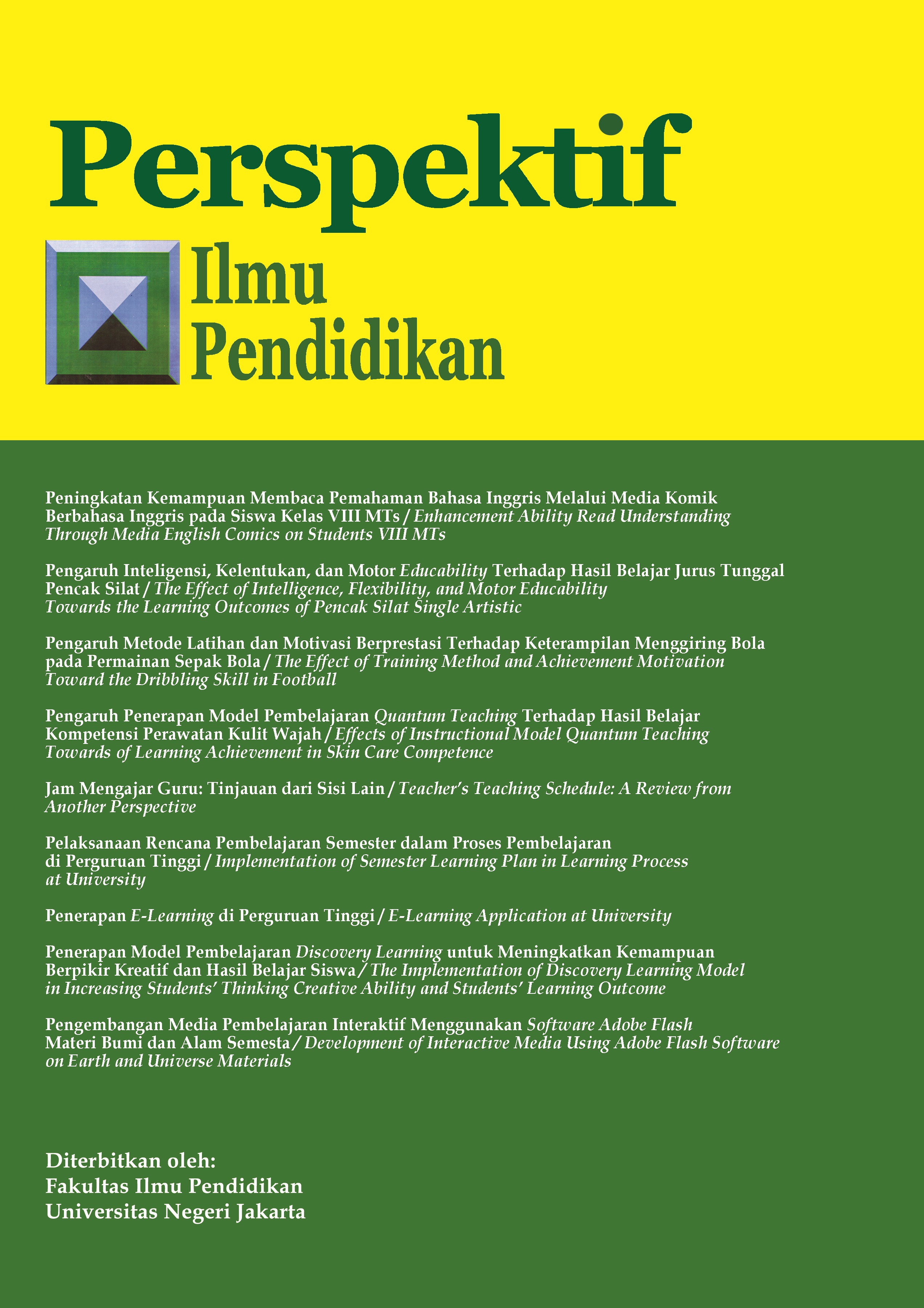PENERAPAN MODEL PEMBELAJARAN DISCOVERY LEARNING UNTUK MENINGKATKAN KEMAMPUAN BERPIKIR KREATIF DAN HASIL BELAJAR SISWA
DOI:
https://doi.org/10.21009/PIP.321.8Keywords:
discovery learning, creative thinking, learning outcomesAbstract
The study aims to find and describe the model of Discovery Learning in increasing students’ thinking creative ability and the results of five-grader student SD Negeri Sidorejo Kidul 02, Tingkir. The study was conducted in SD Negeri Sidorejo Kidul 02, Tingkir on 9 March, 2018. The type of the study which is Classroom Action Research (PTK) has done in 2 cycles. One cycle consists of four stages: planning, action, observation, and reflection. The total students of subjects of the five-grader research were 39 students. The study was used test and non test data collection. The study was used both quantitative and qualitative analysis.The initial condition percentage of creative thinking ability is 33.2% and the average score was 13.3. The completeness learning results were 38% with an average was 60, 72,5 for the highest score, 45 for the lowest score. Cycle I, students' creative thinking ability was 73%, with an average score was 29,2. Presentation of learning result was 71.8%, an average score was 69.48, 82.5 for the highest score and 50 for the lowest score. Cycle II, percentage of creative thinking ability was 81.2%, an average score was 32.2. The learrning result was in average of 74.2, 87.5 for the highest score and 55 for the lowest score. It can be concluded that the implementation of the Discovery Learning model can increase the ability of creative thinking and the learning outcomes of students’ thematic learning for five-grader students in SDN Sidorejo Kidul 02 Tingkir.
References
Al-Khalili, A. (2005). Mengembangkan kreativitas anak. Jakarta: Pustaka AL Kautsar.
Anugraheni, I. (2017). Analisa faktor-faktor yang mempengaruhi proses belajar guru-guru sekolah dasar. Jurnal Manajemen Pendidikan, 4(2), 205-212. doi: https://doi.org/10.24246/j.jk.2017.v4.i2.p205-212
Anugraheni, I. (2017). Penggunaan portofolio dalam perkuliahan penilaian pembelajaran. Jurnal Pendidikan Dasar Perkhasa, 3(1), 246-258. doi: https://doi.org/10.31932/jpdp.v3i1.40
Arikunto, S. (2008). Penelitian tindakan kelas. Jakarta: PT Bumi Aksara.
Darmadi. (2017). Pengembangan model dan metode pembelajaran dalam dinamika belajar siswa. Yogyakarta: CV Budi Utama.
Depdiknas. (2006). Kurikulum tingkat satuan pendidikan (KTSP). Jakarta: Departemen Pendidikan Nasional.
Hanifah, U., & Wasitohadi. (2017). Perbedaan efektivitas antara penerapan model pembelajaran discovery dan inquiry ditinjau dari hasil belajar IPA siswa. Jurnal Mitra Pendidikan, 1(2), 92-104. https://e-jurnalmitrapendidikan.com/index.php/e-jmp/article/view/60
Indriasih, A. (2015). Pemanfaatan alat permainan edukatif ular tangga dalam penerapan pembelajaran tematik di kelas III SD. Jurnal Pendidikan, 16(2), 127-137. http://jurnal.ut.ac.id/index.php/JP/article/view/253
Kristin, F., & Rahayu, D. (2016). Pengaruh penerapan model pembelajaran discovery learning terhadap hasil belajar IPS pada siswa kelas 4 SD. Scholaria: Jurnal Pendidikan & Kebudayaan, 6(1), 84-92. doi: https://doi.org/10.24246/j.scholaria.2016.v6.i1.p84-92
Kristin, F. (2016). Analisis model pembelajaran discovery learning dalan meningkatkan hasil belajar siswa SD. Jurnal Pendidikan Dasar Perkhasa, 2(1), 90-98. doi: https://doi.org/10.31932/jpdp.v2i1.25
Maharani, Y. B., & Hardini, I. T. A. (2017). Penerapan model pembelajaran discovery learning berbantuan benda konkret untuk meningkatkan hasil belajar IPA. Jurnal Mitra Pendidikan, 1(5), 249-561. https://e-jurnalmitrapendidikan.com/index.php/e-jmp/article/view/106
Mawardi, H., dkk. (2014). Penerapan pembelajaran tematik untuk meningkatkan aktivitas belajar kelas I SD. Jurnal Pendidikan dan Pembelajaran, 3(7), 1-9.
Sani, R. (2014). Pembelajaran saintifik untuk implementasi kurikulum 2013. Jakarta: PT. Bumi Aksara.
Downloads
Published
How to Cite
Issue
Section
License
Authors who publish with this Journal agree to the following terms:
- Author retain copyright and grant the journal right of first publication with the work simultaneously licensed under a creative commons attribution licensethat allow others to share the work within an acknowledgement of the work’s authorship and initial publication of this journal.
- Authors are able to enter into separate, additional contractual arrangementfor the non-exclusive distribution of the journal’s published version of the work (e.g. acknowledgement of its initial publication in this journal).
- Authors are permitted and encouraged to post their work online(e.g. in institutional repositories or on their websites) prior to and during the submission process, as it can lead to productive exchanges, as well as earlier and greater citation of published works.
-
Users/public use of this website will be licensed to CC BY-NC-SA Creative Commons Attribution-NonCommercial-ShareAlike 4.0 International License












